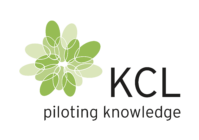Understanding KCL’s Cellulose Nanofiber Technology
At KCL, we have developed a cutting-edge cellulose nanofiber (CNF) technology that leverages wood-based raw materials to create advanced packaging solutions. Our unique portfolio includes cellulose nanofibers with various surface functionalities, such as cationic units, phosphoric acid, or sulphonic acid functionalities. These functionalities are attached to the fibres, which have diameters close to 4 nm and lengths varying from 200 nm to several micrometres. This results in full optical transparency when dispersed in water.
Our cellulose nanofibers form highly viscous solutions in water, providing excellent stabilisation effects for dispersions. When applied to paper or plastic surfaces, CNF forms highly packed assemblies that generate excellent barrier structures, particularly against the diffusion of oxygen. This makes our technology a versatile and powerful tool for enhancing packaging materials.
By integrating KCL’s cellulose nanofiber technology into your packaging materials, you can achieve superior performance and sustainability. Our technology is designed to meet the growing demand for eco-friendly packaging solutions without compromising on quality or functionality.
Advantages of Using Cellulose Nanofibers in Packaging
One of the primary advantages of using cellulose nanofibers in packaging is their ability to enhance the mechanical properties of the materials. CNF can significantly improve the strength and durability of packaging, making it more resistant to wear and tear. This is particularly beneficial for products that require robust packaging to ensure safe transportation and storage.
Another key benefit is the excellent barrier properties provided by CNF. When applied to packaging materials, cellulose nanofibers create a dense network that effectively blocks the passage of gases such as oxygen. This is crucial for preserving the freshness and quality of perishable goods, extending their shelf life and reducing food waste.
Additionally, cellulose nanofibers offer remarkable optical properties. Their small size and high transparency make them ideal for creating clear and visually appealing packaging. This can enhance the aesthetic appeal of your products, making them more attractive to consumers and improving brand perception.
Applications of Cellulose Nanofiber Technology in Packaging
KCL’s cellulose nanofiber technology can be utilised in a wide range of packaging applications. One prominent application is in the food and beverage industry, where CNF can be used to create packaging that maintains the freshness and quality of products. The excellent barrier properties of CNF make it ideal for packaging perishable items such as fruits, vegetables, and dairy products.
Another application is in the pharmaceutical industry, where the stability and barrier properties of CNF can be used to protect sensitive medications from environmental factors. This ensures that the medications remain effective and safe for consumption over extended periods.
Furthermore, CNF can be used in the development of sustainable packaging solutions for consumer goods. By incorporating cellulose nanofibers into packaging materials, companies can reduce their reliance on non-renewable resources and minimise their environmental footprint. This aligns with the growing consumer demand for eco-friendly packaging options.
Environmental Benefits of Cellulose Nanofiber Enhanced Packaging
One of the most significant environmental benefits of using KCL’s cellulose nanofiber technology in packaging is its sustainability. Cellulose nanofibers are derived from renewable wood-based raw materials, making them an eco-friendly alternative to traditional packaging materials. This helps reduce the reliance on fossil fuels and lowers the carbon footprint of packaging production.
Additionally, CNF-enhanced packaging is biodegradable and compostable, which means it can break down naturally without causing harm to the environment. This is a crucial advantage in the fight against plastic pollution, as it offers a viable solution to the growing problem of plastic waste.
Moreover, the use of cellulose nanofibers in packaging can contribute to a circular economy. By creating packaging materials that are both sustainable and high-performing, we can promote the reuse and recycling of resources, reducing waste and conserving natural resources. This not only benefits the environment but also supports the long-term viability of the packaging industry.
In conclusion, KCL’s cellulose nanofiber technology offers a range of benefits for enhancing packaging materials. From improving mechanical properties and barrier performance to providing sustainable and eco-friendly solutions, our CNF technology is at the forefront of advanced packaging solutions. By integrating our technology into your packaging processes, you can achieve superior performance, sustainability, and consumer appeal.
